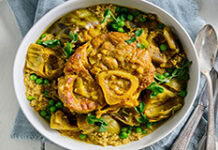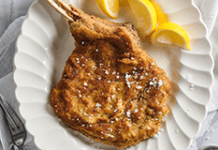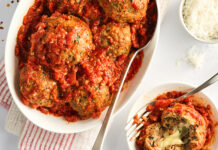When you want to pull out all the stops, this crafted deep-dish lasagna is sure to impress. It’s hard to go wrong when you have all these beautiful ingredients: ground veal cooked down with vegetables, broth and milk into a thick Bolognese-style sauce, layered with homemade pasta, creamy béchamel sauce and LOTSA Parmesan cheese. Shortcut: Just make the Veal Bolognese to enjoy simply tossed with hot cooked pappardelle, spaghetti or fettuccine. Recipe adapted from the original developed by Chef Dwight Smith.
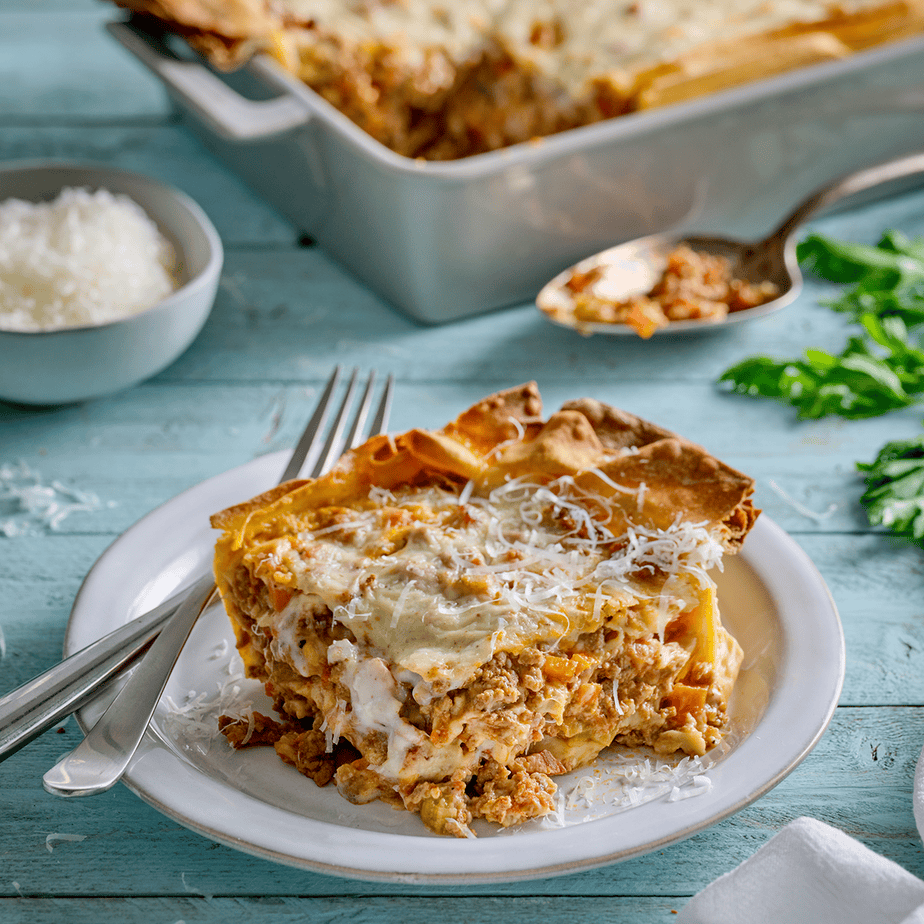
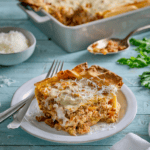
Lasagna Veal Bolognese
- Prep Time: 2 hours
- Cook Time: 3 hours
- Total Time: 7 hours
- Yield: Makes 8 servings 1x
Ingredients
Veal Bolognese
¼ cup (60 mL) olive oil, divided
2 lb (1 kg) Lean Ground Veal
½ tsp (2 mL) EACH salt and cracked black pepper, divided (approx)
½ cup (125 mL) diced pancetta or double-smoked bacon (about 3 oz/90 g)
1 cup (250 mL) EACH diced onion, carrots and celery
¼ cup (60 mL) dry white wine
1 cup (250 mL) 2% milk
1 cup (250 mL) no-salt-added chicken broth
1 can (28 oz/796 mL) plum tomatoes, chopped
Béchamel
¼ cup (60 mL) unsalted butter, diced
⅓ cup (75 mL) all-purpose flour
4 cups (1 L) 2% milk, heated
¾ tsp (4 mL) each salt and fresh ground pepper
½ tsp (2 mL) ground nutmeg
Pasta Dough
1½ cups (375 mL) all-purpose flour
3 large egg yolks
1 large egg
1 tbsp (15 mL) olive oil
Ice water
Assembly
1 tbsp (15 mL) olive oil (approx)
1 cup (250 mL) freshly grated Parmesan cheese (about 3 oz/90 g)
Instructions
- Veal Bolognese: Heat 2 tbsp (30 mL) of the oil over medium-high heat in a heavy-bottomed pot. Add veal and ¼ tsp (1 mL) each of the salt and pepper. Cook, stirring often and using back of spoon to break up meat into small chunks, for about 20 minutes, until liquid is evaporated and meat is very well browned. Transfer to a bowl.
- Add remaining oil to pot; cook pancetta, without stirring, for 2 minutes to release the fat. Add onion, carrots, celery and the remaining ¼ tsp (1 mL) each salt and pepper; cook, stirring, for 5 minutes or until softened. Return veal to pot; stir to combine. Pour in wine; bring to a simmer, stirring and scraping up brown bits from pot. Stir in milk, broth and tomatoes; bring to a simmer. Reduce heat and simmer for about 1½ to 1¾ hours, stirring occasionally, until very thick (there should be about 7 cups/1.75 L). Season with salt and pepper to taste, if desired. Transfer to a bowl; let cool before assembling the lasagna.
- Béchamel: Meanwhile, melt butter over low heat in a medium saucepan; sprinkle in flour and cook, stirring, for 2 minutes. Gradually pour in milk, while whisking constantly. Increase heat to medium; cook, stirring often, for about 12 minutes or until bubbling and thickened enough to coat the back of a spoon. Remove from heat and season with salt, pepper and nutmeg. Transfer to a bowl; let cool before assembling the lasagna.
- Pasta: Place flour on a sturdy work surface in a mound and create a well in the centre. Add egg yolks, egg, olive oil and 1 tbsp (15 mL) water. Carefully mix with a fork to gradually incorporate liquid and flour until dough starts to come together, adding more water, a few drops at a time, if necessary to hold dough together. Gather into a ball and knead for 4 to 5 minutes or until the dough is smooth. Wrap tightly with food storage wrap and let rest for 30 minutes at room temperature.
- Cut dough into quarters; press each into a rectangle. Roll out one piece at a time using a pasta machine according to manufacturer’s directions to sheets about 5 inches (12.5 cm) wide and very thin, to about #5 thickness (or the second thinnest setting). As you roll, cut the strip in half crosswise to make rolling more manageable, then continue rolling to make 8 sheets total, each about 16 inches (40 cm) long or the dimensions required to line casserole dish with a 1-inch (2.5 cm) overhang. Layer rolled pasta sheets on a large baking sheet, lightly dusting with flour between layers. Cover with food storage wrap.
- Cook pasta sheets, in batches, in a large pot of boiling salted water for 1 minute; transfer with a slotted spoon, draining well, into a large bowl of ice water to cool. Drain.
- Assembly: Brush a 12- x 8- x 2½-inch (30 x 20 x 6 cm) or 12-cup (3 L) casserole dish (see Tip) with olive oil. Line 2 pasta sheets (see Tip*) lengthwise in dish, overlapping sheets slightly down the centre and lining pasta up sides of dish, letting edges hang over rim of dish by about 1 inch (2.5 cm); gently tuck into corners of dish. Spread with one-quarter (about 1¾ cups/425 mL) of the Veal Bolognese; dollop one-quarter (just over ¾ cup/175 mL) of the Béchamel on top and spread evenly. Sprinkle with ¼ cup (60 mL) of the Parmesan. Repeat to make 4 layers total, pressing lightly on pasta layer and tucking into corners before adding sauce. Trim off edges of pasta that hang over more than ¾ to 1 inch (2 to 2.5 cm).
- Place a rimmed baking sheet on oven rack below the middle rack in preheated 375°F oven (to catch any drips). Bake lasagna on middle rack over baking sheet for about 50 minutes or until filling is bubbling and edges are browned. Let stand for 30 minutes before serving.
Notes
Tips: This works best in a deep casserole dish, about 2½ inches deep. Be sure the volume of your dish is about 12 cups (3 L) when measured with water up to the top edge of the dish for the best fit. If your dish is larger in dimension than called for, divide all of the ingredients into thirds rather than quarters when assembling and make 3 layers total.
When lining the dish with pasta sheets, if sheets are slightly different sizes, use the largest sheets for the bottom layer of pasta and the smallest sheets for the top layers.
To make ahead, prepare the Veal Bolognese and the Béchamel up to 3 days ahead. Let cool, cover and refrigerate separately. Before assembling, let Béchamel come to room temperature and reheat Veal Bolognese in a saucepan over medium-low just until saucy, but not hot. The pasta dough can be rolled out up to 8 hours ahead of cooking. Layer on the baking sheet as directly, tightly wrap sheet with food storage wrap and refrigerate pasta until cooking.

